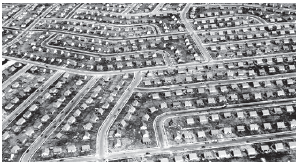To appeal to suburban voters in late summer 2020, President Trump tweeted that “people living their Suburban Lifestyle Dream” would “no longer be bothered or financially hurt by having low income housing built in your neighborhood.” The tweet referred to the president’s gutting of the Affirmatively Furthering, which required local governments to affirmatively address racial segregation as required by the 1968 Fair Housing Act. He continued, “Your housing prices will go up based on the market, and crime will go down. I have rescinded the Obama-Biden AFFH Rule. Enjoy!”
President Trump’s HUD Secretary Ben Carson concurred with President Trump’s desire to roll back fair housing enforcement at HUD. In an op-ed shortly after President Trump’s tweet, then Secretary Carson affirmed the president’s abhorrent rhetoric by stating that fair housing practices could lead suburbs to become dens of “crime and chaos,” suggesting that low-income people are inherently criminal. This type of comment has obvious racist elements, as a disproportionate number of low-income people in this country are Black or Hispanic.
While President Trump’s and Secretary Carson’s words played to deplorable racist perceptions of people living in affordable housing, the vision of the suburbs they paint is also incorrect. The exclusive, white, middle-class vision of the suburbs is rapidly changing. Whites fled cities to move to outlying majority white middle-class enclaves in the mid-1900s, a phenomenon known as “white flight.” The federal government encouraged whites to move to suburbs by constructing federal highways and providing white families low-interest mortgages for homes in car-centric, less dense neighborhoods. Racist residential segregation policies, like redlining, housing discrimination, and racially restrictive covenants, limited opportunities for people of color to follow the same path.
But like all of America, the suburbs are diversifying. Across the country, the share of non-Hispanic whites in the suburbs is declining as people of color move into previously majority-white neighborhoods outside of central metro areas. Researchers point to many causes for this change, including suburban housing stock becoming more affordable as it ages, fewer barriers for people of color to afford homes in suburbia, the rising cost of housing and displacement in urban areas, and increasing job opportunities outside of cities.
 Just because suburbs have diversified does not mean they are integrated, however. White flight persists in a new form. Studies show that as neighborhoods get more diverse, many whites leave to further-out exurbs or return to center cities. In some cases, white higher-income residents are displacing communities of color in urban areas. As Thomas Sugrue from the NYU Cities Collaborative writes, “While in the aggregate, suburbs are more diverse, the distribution of nonwhites isn’t random. Metropolitan America is not a place of free housing choice. It’s still very much shaped by deep patterns of racial inequality and a maldistribution of resources.”
Just because suburbs have diversified does not mean they are integrated, however. White flight persists in a new form. Studies show that as neighborhoods get more diverse, many whites leave to further-out exurbs or return to center cities. In some cases, white higher-income residents are displacing communities of color in urban areas. As Thomas Sugrue from the NYU Cities Collaborative writes, “While in the aggregate, suburbs are more diverse, the distribution of nonwhites isn’t random. Metropolitan America is not a place of free housing choice. It’s still very much shaped by deep patterns of racial inequality and a maldistribution of resources.”
In 2011, the Brookings Institution pointed out that many suburbs, including those in Houston, Las Vegas, and San Francisco, have become majority non-white, but white residents accounted for 73% of the growth in further outlying exurban areas. Continued racial segregation can be seen in cities like Atlanta, where in 2010, 87% of the Black population lived in the suburbs—but in largely segregated Black neighborhoods.
As fair housing advocates strive to address residential segregation, the suburbs offer many opportunities for an increase racial and socioeconomic inclusion. Even in as the demographics of suburbs have changed, the suburban single-family home on a large lot with a white picket fence ideal has not faded. There is still opposition to multifamily housing and dense development. As suggested by the Urban Institute and championed by NLIHC, local policies can encourage inclusivity and opportunity by building more affordable housing, enforcing fair housing protections, reforming restrictive zoning laws, and expanding access to rental assistance for low-income households.